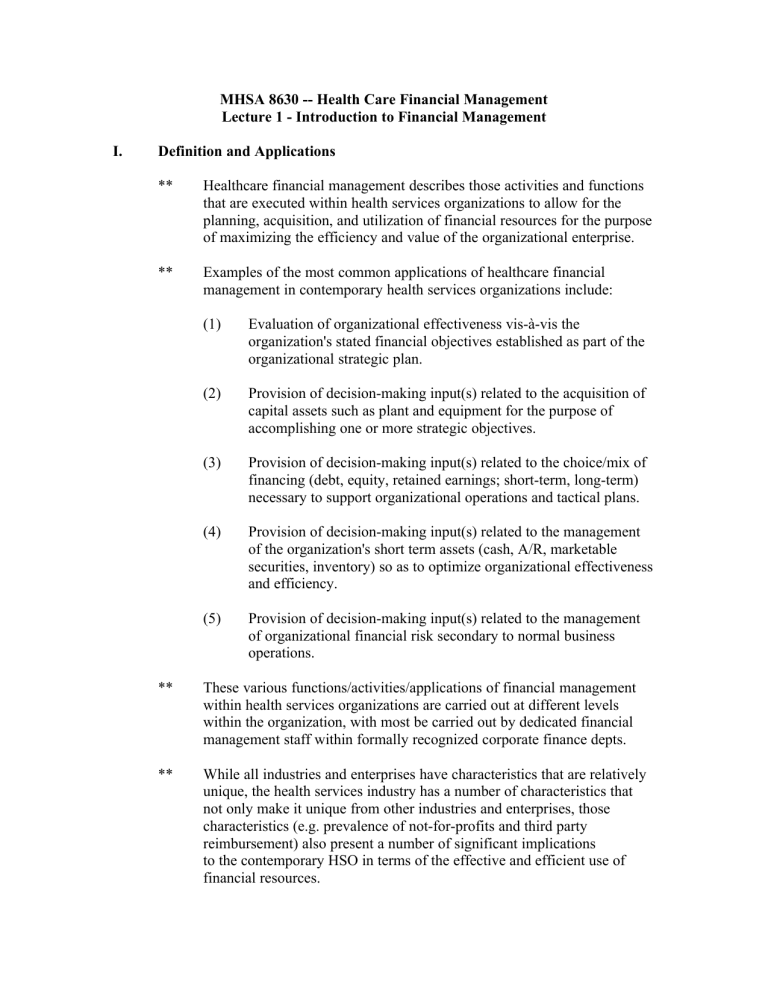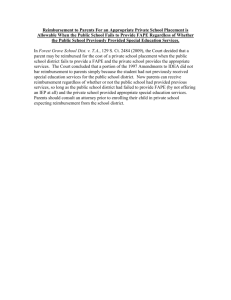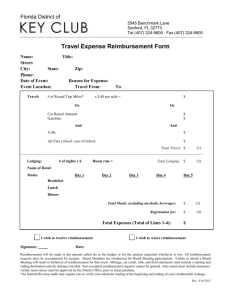MHSA 8630 -- Health Care Financial Management Lecture 1

I.
Definition and Applications
** Healthcare financial management describes those activities and functions that are executed within health services organizations to allow for the planning, acquisition, and utilization of financial resources for the purpose of maximizing the efficiency and value of the organizational enterprise.
**
MHSA 8630 -- Health Care Financial Management
Lecture 1 - Introduction to Financial Management
Examples of the most common applications of healthcare financial management in contemporary health services organizations include:
(1) Evaluation of organizational effectiveness vis-à-vis the organization's stated financial objectives established as part of the organizational strategic plan.
(2) Provision of decision-making input(s) related to the acquisition of capital assets such as plant and equipment for the purpose of accomplishing one or more strategic objectives.
(3) Provision of decision-making input(s) related to the choice/mix of financing (debt, equity, retained earnings; short-term, long-term) necessary to support organizational operations and tactical plans.
(4) Provision of decision-making input(s) related to the management of the organization's short term assets (cash, A/R, marketable securities, inventory) so as to optimize organizational effectiveness and efficiency.
(5) Provision of decision-making input(s) related to the management of organizational financial risk secondary to normal business operations.
**
**
These various functions/activities/applications of financial management within health services organizations are carried out at different levels within the organization, with most be carried out by dedicated financial management staff within formally recognized corporate finance depts.
While all industries and enterprises have characteristics that are relatively unique, the health services industry has a number of characteristics that not only make it unique from other industries and enterprises, those characteristics (e.g. prevalence of not-for-profits and third party reimbursement) also present a number of significant implications to the contemporary HSO in terms of the effective and efficient use of financial resources.
** The discipline that is healthcare financial management is comprised of two sub-disciplines that are largely inter-related to each other - (1) accounting and (2) corporate finance. The accounting discipline is involved with the systematic recording and reporting, in financial terms, the economic activities of the organization. The discipline of corporate finance provides the theories, concepts, and methods necessary to help managers make better financial decisions, often using data from the accounting discipline.
II.
Historical Evolution of Financial Management in HSO's
** The evolution of contemporary financial management within health services organizations has evolved rapidly over the past 20-30 years.
** Pre-1980's -- the 'cost accounting era' of financial management; virtually all HSO reimbursement cost/charge based; internal emphasis on accurate cost accounting for services provided (cost reports); financial accounting approach utilized exclusively to produce accurate statements of financial performance for external review (rate setting, regulatory review purposes); minimal emphasis on managerial (internal) uses of cost accounting information to control costs or improve operating efficiency. (Why?)
**
**
**
1980's - late 1990's -- 'contemporary financial management era'; passage of TEFRA/PPS (1982) is largely acknowledged to have ushered in this new era of financial management within HSO's; shift in emphasis away from pure cost/financial accounting activities towards increased use of cost accounting information for managerial (internal) uses as described above. (cost containment and improve operating efficiency).
The passage of TEFRA/PPS introduced into the health services marketplace sweeping changes, not the least of which was the change in reimbursement approach from a retrospective, cost/charge-based approach to a more prospective, fixed-reimbursement approach with DRG's. Such a change in reimbursement approach had the effect of shifting some (not all) of the financial risk of health services delivery away from the payer
(Medicare) towards the provider (hospital). The element of financial risk is conceptualized in this case as an increase in the uncertainty regarding both the expected costs of service delivery in a specific case as well as uncertainty regarding reimbursement for a specific case (DRG assignment).
Over time during this period, more and more payers, including Medicare itself, have adopted such prospective approaches to reimbursing health services providers for everything from inpatient to outpatient hospital services, home health services, long term care services, physician and other professional services, etc., due to the relative success of such methodologies in controlling expenditures for health services.
**
**
**
The net result, over time, of this gradual shift towards non-cost/charge based reimbursement methods has been a fairly dramatic increase in financial risk assumed by health services organizations and providers.
Early after the passage of TEFRA/PPS, HSO's sought to minimize the impact of this increased financial risk from Medicare by making up for
Medicare losses on other third party payers (commercial). As the 1990's progressed, more and more commercial payers adopted similar prospective methods of reimbursement, making it less likely that HSO's were able to offset financial risk by cost-shifting.
Significant increases in organizational financial risk, accompanied by a general oversupply of various types of health services providers, has led to an increased risk of organizational financial failure (e.g. bankruptcy, foreclosure) among many HSO's. The notion of hospitals, physicians, home health agencies, etc. going bankrupt, previously unheard of prior to the early 1990's, is now not uncommon, especially in certain areas (rural).
** For all of the above reasons (and others), the need to more closely manage the financial assets of health services organizations in no longer only an issue of profitability/performance but is increasingly a survival issue, as failure to appropriately manage such resources can lead to financial ruin.
III.
The Environment of Financial Management in HSO's
** The organizational form is by far the most common structural entity within which systematic financial management practices are conducted.
The legally recognized organizational form that a health services provider assumes will have obvious implications with respect to financial management goals/objectives and activities. (more below)
** The three primary legal forms of organizations are as follows:
(1) Proprietorship -- aka sole proprietorship; single owner of organizational resources; owner assumes complete liability for organizational performance. Primary advantages related to ease/low cost of establishment/maintenance; primary disadvantages related to lack of transferability of ownership, greatest liability risk of all forms, and limitations of organizational life to the owner him/her self.
(2) Partnership -- more than one owner of organizational resources; owners jointly share liability for organizational performance. The extent to which liability is shared by partners determines type of partnership involved (general vs. limited). Similar advantages and disadvantages as proprietorship (somewhat more complex).
**
(3) Corporation -- a legally devised (fictional) entity that is considered separate and distinct from its owners/managers. In such organizational forms, there can be a virtually unlimited number of owners (shareholders/stockholders) of the organization's resources
(dependent on number of shares encumbered). Liability for organizational performance, however, is necessarily limited to each individual shareholder to the amount/shares of stock they are in possession of at a particular point in time.
** The primary advantages of corporations (and the reasons why they are the most common organizational form of the three) are related to (1) limit of liability to individual owners based on the number of shares of the company's stock they own (liability advantage); (2) theoretically unlimited life of the corporate form (risk advantage); (3) ease of transferability of ownership via the sale of stock
(liquidity advantage).
**
Within these various organizational types, there exist alternative ownership forms of two primary types - for-profit organizations and notfor-profit organizations.
**
The primary disadvantages of corporate forms are related to the cost and complexity associated with establishing and maintaining such entities and the specter of double taxation of corporate earnings (if taxable).
For-Profits -- aka investor-owned organizations; includes almost all proprietorships and partnership and many corporations; ownership is vested in such forms via the purchase/sale of shares of organizational stock.
** In a sole proprietorship, the owner owns 100% of the company’s "stock" - resources. In a three owner general partnership, each owner owns 33.3% of the company's
"stock" - resources.
** For the corporate form, ownership is similarly vested vis-àvis the sale of company stock. Such stock may be (1) privately held or placed (small number of owners) or (2) publicly held or placed (large number of owners) in either/both the primary market and/or the secondary market. (primary - IPO's; secondary - NYSE, NASDAQ)
** Owners of organizational stock, regardless of organizational form, are similar in the following ways:
**
**
**
(1) They have the right to exercise control over organizational operations. Such rights are often exercised by controlling the election of the governing board of the organization and voting by proxy (based on shares owned) on matters pertinent to the organization.
(2) They have the right to any residual earnings of the organization - dividends, profits, capital gains.
(3) They have the right to any/all proceeds from organizational liquidation proceedings after creditor claims have been satisfied.
Not-for-Profit -- aka tax exempt organization, charitable organization, etc. Includes many corporate forms and a few proprietorships/partnerships. Unlike the case with investor-owned, for-profit forms, not-for-profits do not vest ownership of organizational resources based on sale of stock to shareholders.
Because NFP's have no officially recognized shareholders, no single body of individuals has ownership rights as delineated above. Rather, the "community" at large "owns" the resources of
NFP's, with the community at large represented (in terms of governance) by a community based board of trustees.
** NFP's are, due to their tax exempt nature, generally exempt from all forms of taxation (federal, state, local), and also have the right (in specified circumstances) to issue tax exempt debt to finance capital asset acquisition and accept charitable, tax exempt contributions from individuals and other taxable entities.
As in all other industry cases, ownership type matters significantly as it relates to organizational behavior and financial management objectives.
For the investor-owned organization, the primary objective of financial management activities is to maximize shareholder wealth. For the not-forprofit organization, the primary objective of financial management activities is related to some defined organizational mission, such as to improve the health of the communities served.
Realistically, despite the differences mentioned, there is little difference between the day-to-day financial objectives of both FP and NFP organizations - they both need to manage financial resources in such a way as to ensure the viability of the organization and support general organizational goals.
** Organizational Taxation Issues
** All investor owned organizations and even some not-for-profit organizations are required under the Federal Tax Act of 1913 to pay federal taxes on some/all of the residual earnings of the enterprise. Various state and local taxes also must be paid by many/most of these same corporations.
** The impact of taxation, at various levels, on the organizational behavior and financial management of these entities is significant.
The net effect of taxation is to reduce the amount of residual earnings that are available for other purposes, such as paying shareholders, investing in new services, etc.
**
**
As taxation reduces the level of residual earnings within the enterprise, such taxation has the real economic effect of reducing the value, over time, of the enterprise as a whole, as measured by the stream of discounted cash flows the enterprise generates.
The level and extent of taxation on an organizational enterprise is highly dependent on the organizational form the enterprise assumes as well as consideration of ownership:
** Proprietorships/Partnerships – non-corporate organizational forms; residual earnings are taxed at the level of the individual based on personal marginal rates of taxation under existing law. Currently, personal income taxes must be paid on (1) ordinary income, including wages/salaries and dividends/taxable interest income; (2) capital gains income. Each type of income is taxed under a different tax scheme at different rates.
** Corporations – residual earnings are taxed at the level of the corporation based on corporate marginal rates of taxation under existing law.
** Investor owned corporations are required to pay the corporate income tax on all sources of residual earnings including the following: (1) ordinary income from operations; (2) interest income from debt investments; (2) a portion (30%) of dividend income received from equity investments (why??);
(4) capital gains income from equity investments.
**
**
**
Not-for-profit organizations are typically exempt from all forms of taxation – federal, state, and local.
An NFP corporation, however, may be required to pay some form of tax on its residual earnings associated with unrelated business activities .
Such residual earnings, known in tax parlance as unrelated business income (UBI), are typically generated by a NFP enterprise where the business activity is not substantially related to the charitable mission of the organization and is carried out with the same frequency and regularity of investorowned enterprises. The IRS requires annual UBI tax returns from NFP enterprises where the gross income from such activities exceeds $1K/year.
NFP organizations are also allowed under current tax law to invest temporary cash surpluses in shortterm securities (debt, equity, cash) and the proceeds from such investments (interest, dividend income) is typically tax exempt as well.
Miscellaneous Tax Issues:
** Under current tax law, all investor owned (taxable) corporations are allowed to deduct completely the interest expense associated with debt financing, whether in the form of a bank loan or a corporate bond issue. The net effect of the exclusion of interest expense is to effectively reduce the level of taxable residual earnings for the enterprise, thus reducing the level of taxation and increasing after-tax cash flow for the organization.
**
**
Unlike interest expense, investor-owned corporations are not allowed to deduct any of the expense associated with paying a dividend to shareholders, effectively requiring the payment of all dividends with after-tax dollars. The fact that the corporation’s residual earnings are taxed once at the corporate level and then any dividends paid by the corporation are taxed again at the personal/corporate level by the recipient of those dividends is often referred to as the “double taxation of dividends”.
This disparity in tax treatment at the corporate level between debt (interest) expense and equity (dividend) expense obviously favors the corporate use of debt financing (leverage) over equity financing, ceteris paribus.
**
** Also of note under current tax law are provisions that allow corporations to use operating losses (negative residual earnings) in a given tax year to offset operating profits
(positive residual earnings) in other years, going back as far as three (3) years and/or forward for fifteen (15) years.
** The tax benefits (in terms of cash flows) of the
“carry-back” provision are potentially immediate, where the organization may be entitled to a tax rebate in the present based on the carry-back of a present operating loss to a year over the past three where an operating profit was reported and corporate taxes were paid.
** The tax benefits (in terms of cash flows) of the
“carry-forward” provisions do not materialize immediately, and often take years (if at all) for the organization to realize any tax savings as a result.
Organizational Reimbursement Issues
**
**
**
While taxation can (and does) have an indirect effect on organizational cash flow and financial performance as a result, nothing has perhaps as direct an impact on the cash flow and financial performance of a health services organization as does the issue of third party reimbursement for services provided.
The U.S. system of health services financing is dominated by the presence of innumerable third parties – mostly insurance companies, managed care organizations, and governmental payers
– that provide the large majority of the funding (80-85%) or sources of funding for health services.
Though the number of third party payers in quite large in the U.S.
system, and the number of potential funding sources for health services organizations significant as a result, the reality is the market as a whole is dominated by a few large third party payers, primarily governmental payers (Medicare, Medicaid, Tricare) and a few commercial payers (large managed care payers). As a result, the marketplace overall exhibits a significant amount of market concentration, with the large payers setting the market price(s) for all health goods/services and providers essentially reduced to the role of a price-taking firm with no significant market power to effectively influence the market price for its goods/services.
**
**
In terms of methods of reimbursement, the following generic mechanisms are commonly utilized by most third party payers:
** Fee-for-service : level of reimbursement is directly related to the intensity of services provided. Most common variations include: (1) cost-based reimbursement
(allowable cost reimbursement under Medicare); (2) charge-based reimbursement (UCR, discounted charges);
(3) prospective forms of reimbursement, including reimbursement by diagnosis (DRG’s), by day (per-diem rates for inpatient services), by procedure (APC’s,
RBRVS), by episode of care (global rates, case rates).
**
**
Capitation : level of reimbursement inversely related to the frequency/intensity of services provided. Reimbursement per capita (PMPM).
Non-payment : includes bad debt losses (individuals able to pay but don’t) and uncompensated/charity care (individuals unable to pay due to financial status). May also include outright denial of payment by third party.
For each of these different forms of third party reimbursement, there are different sets of issues to consider as it relates to the accounting of revenues under each system, some of the elements of financial risk inherent with each type, and the presence (or absence) of provider incentives to economize under each system:
** Fee-for-service – accounting for revenues based on actual revenues received vs. revenues billed. Any difference between the two must be accounted for separately on the income statement. Little in the way of financial risk assumed by the provider of a service under cost (none) and charge-based (some) reimbursement. More risk assumed under prospective forms (utilization risk as represented by uncertainty about expected costs per procedure, per diagnosis, per case, per episode of care, etc.), with increasing risk across the prospective payment continuum.
Provider incentives to economize with respect to the provision of health services also vary across this continuum, with the fewest incentives present under costbased reimbursement and the greatest incentives present under episode-based prospective reimbursement (global forms of reimbursement).
** Capitation -- accounting for revenue under this method is fairly simple, as revenue amounts are for the most part known in terms of amount as well as timing. Highly dependent on an accurate accounting of per capita membership in a provider's "panel" as this is what drives revenues (PMPM). The financial risk assumed by providers under capitation is substantial, including elements of both utilization risk (expected costs as built into PMPM vs. actual costs) as well as actuarial risk (the possibility of a significant number of catastrophic, highcost cases aggregating to a specific provider. In terms of provider incentives to economize with respect to the provision of health services, this method obviously provides the strongest incentives compared to the others discussed to not only minimize the cost of services provided but also to minimize utilization of services to those that are most medically necessary.




